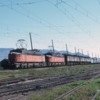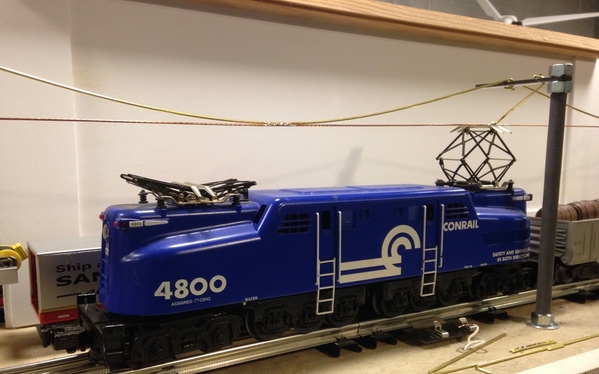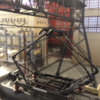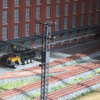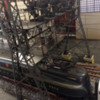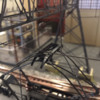Running GG1s under nothing but the sky was just not cutting it. I am building a crude system, for now, with plans to enhance it as time allows.
Replies sorted oldest to newest
Looks like your off to a good start.
Dave
I love it.
I always wondered when its on and you touch it , will it shock you, cause its center rail?
What voltage are you running?
Your simple system is prototypical. Way back when, the Milwaukee Road electrified Western Route looked just like your setup, except that they didn't run GG1's. As you know that engine was unique to the Pennsylvania RR and later NJT and Conrail.
Jushavnfun posted:I love it.
I always wondered when its on and you touch it , will it shock you, cause its center rail?
What voltage are you running?
I plan to make it live. No, it won't cause any pain if you touch it. That is unless you happen to have an open cut somewhere on your hands or arms. It happened to me once. I was working on my layout and an open cut hit the center and outside rail. Not quite as shocking as 110 volts but startling just the same.
I'm running standard voltage for our trains, 0-20 volts.
Dennis LaGrua posted:Your simple system is prototypical. Way back when, the Milwaukee Road electrified Western Route looked just like your setup, except that they didn't run GG1's. As you know that engine was unique to the Pennsylvania RR and later NJT and Conrail.
Yes, the Milwaukee system was child's play compared to the Pennsy's catenary system. In many places the MR simply used wood poles. The Milwaukee Road had their own unique variety of locomotives. A pity they abandoned overhead power in the seventies.
Attachments
Thanks for sharing Dan! The "simple" system you have now is quite elegant, far from crude. ![]()
Dan, the catenary you are building looks good, I worked for NICTD in Northwest Indiana and their catenary system is similar to your design. I was considering the construction of a catenary system and would use this same design. Keep up the construction you may need to add inclined struts mounted off the poles in the curves to keep the catenary within track gauge for pantograph contact. If my memory is correct the upper (trolley) has the parabolic bow, the bottom(messenger) wire is level and makes the contact with the pantograph, the hangers that support the messenger from trolley wire vary in length because of the quasi- parabolic shape.
Very nice Dan, can you tell us what materials you are using, and maybe a close up image?
Very cool, looks like it will just be a matter of time for your empire to be "overhead electrified". Keep the pictures coming as changes occur, very enjoyable
I just remembered who it was that gave me the idea to build a catenary system using bolt rod and flat plates, Pantenary, one of our forum members. I was so inspired by his work and thought how simple yet robust.
Good evening Mr. Padova:
Welcome, welcome BACK to the dark side of the tracks. ![]()
--NMM
So tonight I did some alterations to the part of the catenary that is visible. It's a twelve foot stretch along the front of the layout. I wasn't happy with the individual sections I had previously. My brainstorm is that I stretched a piece of copper ground wire, the type you might see on a chandelier. It's bare copper twisted wire about sixteen or eighteen gauge. On one end I have a turnbuckle that keeps the wire taught. Then, using the 1/16" diameter brass rod, I created the catenary support wire.
This system is more durable and much straighter. I does not have the many hangers that a catenary system usually has, but it is in keeping with my KISS system.
The poles are 3/8" diameter bolt rod covered with heat shrink tubing. The lateral beams are 1/8" x 1/2" aluminum stock.
Attachments
Looks good Dan. Are you going to power it eventually?
Dan,
Nothing crude about your system. It looks and works fine. I am also in the process of building a live catenary system. It is a lot of work but worth the effort.
Ed
The catenary poles look good, and they certainly appear to be quite sturdy. And the heat shrink was near perfect for a covering. Your soldering looks really good - I imagine it was extra tricky since some/all? of the connections were under tension?
Do all your GG-1s and other powered engines have the same height from the top of the rail to the maximum extension of the pantographs?
George
RSJB18 posted:Looks good Dan. Are you going to power it eventually?
That's my next step.
GeoPeg posted:The catenary poles look good, and they certainly appear to be quite sturdy. And the heat shrink was near perfect for a covering. Your soldering looks really good - I imagine it was extra tricky since some/all? of the connections were under tension?
Do all your GG-1s and other powered engines have the same height from the top of the rail to the maximum extension of the pantographs?
George
The GG1 and EP-5s are both comfortable under my catenary contact wire height of just under 6", measured from the table to the wire. E-33 Rectifiers not so. And if I raise the wire to make the E-33s happy, the GG1s and EP-5s don't make contact.
I discovered this back in the '80s, the last time I had operating catenary.
Dan,
What materials did you use?
Sorry. Just read post. Ignor.
Dan Padova posted:GeoPeg posted:The catenary poles look good, and they certainly appear to be quite sturdy. And the heat shrink was near perfect for a covering. Your soldering looks really good - I imagine it was extra tricky since some/all? of the connections were under tension?
Do all your GG-1s and other powered engines have the same height from the top of the rail to the maximum extension of the pantographs?
George
The GG1 and EP-5s are both comfortable under my catenary contact wire height of just under 6", measured from the table to the wire. E-33 Rectifiers not so. And if I raise the wire to make the E-33s happy, the GG1s and EP-5s don't make contact.
I discovered this back in the '80s, the last time I had operating catenary.
Part of the fun for me was to model different heights, as I like to see the pans extend and collapse as they go. This also creates some friction at the pivot points, which, in conjunction with the conductive grease, helps conductivity. The standard height I have used is 5¾", from table to trolley wire. However, the interlockings run closer to 6", while some of the straight runs are 5½". The E33's pan collapses pretty far at times, but overall looks fine to me. I would rather have a bit more compression then run the risk of a floating pan, especially under power. The other pans look and work great under these specs.
Your construction techniques look more like actual models while maintaining robustness; I think I failed in that area. The shrink tubing is a clever idea and looks great. Overall, a very solid construction. One word of caution: it appears to me that your cat poles are (or would be) hot, based on the description and photos. I might try to avoid that, although the shrink tubing certainly helps mitigate potential issues.
I think it is great you started into operating catenary work again. Please continue to post images of your progress as you are able. Perhaps I will run into you this week.
If I was going to build a catenary system I would build like the traction modelers do. Use the wire Qcar sells. If you dig into some of the older model railroaders there are atrticles on how to construct it.
I recommend you pick up a copy of the Traction Guidebook for Model Railroaders, there is a chapter on hanging wire. You can get it here:
I built mine based on Scale Rail's and I am very happy with it, I run Lionel semi scale GG1's and scale Williams with no problem...
Marty
Pantenary posted:Dan Padova posted:GeoPeg posted:The catenary poles look good, and they certainly appear to be quite sturdy. And the heat shrink was near perfect for a covering. Your soldering looks really good - I imagine it was extra tricky since some/all? of the connections were under tension?
Do all your GG-1s and other powered engines have the same height from the top of the rail to the maximum extension of the pantographs?
George
The GG1 and EP-5s are both comfortable under my catenary contact wire height of just under 6", measured from the table to the wire. E-33 Rectifiers not so. And if I raise the wire to make the E-33s happy, the GG1s and EP-5s don't make contact.
I discovered this back in the '80s, the last time I had operating catenary.
Part of the fun for me was to model different heights, as I like to see the pans extend and collapse as they go. This also creates some friction at the pivot points, which, in conjunction with the conductive grease, helps conductivity. The standard height I have used is 5¾", from table to trolley wire. However, the interlockings run closer to 6", while some of the straight runs are 5½". The E33's pan collapses pretty far at times, but overall looks fine to me. I would rather have a bit more compression then run the risk of a floating pan, especially under power. The other pans look and work great under these specs.
Your construction techniques look more like actual models while maintaining robustness; I think I failed in that area. The shrink tubing is a clever idea and looks great. Overall, a very solid construction. One word of caution: it appears to me that your cat poles are (or would be) hot, based on the description and photos. I might try to avoid that, although the shrink tubing certainly helps mitigate potential issues.
I think it is great you started into operating catenary work again. Please continue to post images of your progress as you are able. Perhaps I will run into you this week.
Nate, that's interesting. The 5 3/4" contact wire elevation works great with my GG1s. You say it's also good with Lionel E-33s. But the wire must be a hair above the top part of the loco ?
I would think the stranded wire might be hard on the pantographs.
SAIL LOCO posted:I would think the stranded wire might be hard on the pantographs.
Possibly. However, the stranded wire is actually easier to work with. I once had a live catenary system in my garden railway. I used stranded 14 gauge wire. Once I removed the insulation, I placed the wire in a drill chuck and tied the other end to my garage. The wire twisted tighter when I turned the drill on. It made it stiffer. I didn't notice any appreciable wear on the pantographs of my ELOKS.
Not the best photos but some of my catenary at the time. I have since removed the catenary our to too much interference with the gardening chores of the head gardener and her minion.....LOL
Attachments
Dan, Yours is a very interesting thread and I hope in adding to it, I am not hijacking here. I am posting to the thread to add some commentary about building/installing catenary. Like you, I was completely unwilling to continue running GG-1s under nothing but air. My problem was how to overcome the difficulty of building and installing a system that looked reasonably good.
It has been my hope in building the new layout that I could install realistic catenary, functional or not, so that electric locomotives could run under catenary. My plan was to have someone (in this case Don Silberbauer of Model Memories) build the towers and the catenary and then I would stumble around and try to make it look reasonably good. I knew I was up against some difficult challenges.
1) Most of my electric locomotives are GG-1's built by different manufacturers.
2) The Lionel GG-1's were never built to run under a catenary system. The JLC GG-1's have fixed pantographs and the Vision Line GG-1's, though the pantographs are flexible, have the sparking LED's so the pantographs cannot pick up electricity. The electrics built by other manufacturers have pantograph height that is, at least, slightly different than the Lionel GG-1's. I do not know how to adjust anything like that.
3) Scale catenary, regardless of how well made, must be installed by someone who knows what the heck he is doing. I do not. I know what looks good, but that is about it.
4) The area to be modeled is a "diorama" style 3' x 16'. There would be no purpose to installing catenary on that line anywhere else because it would be "underground" and hidden. the purpose of the diorama area was to simulate GG-1's and other electrics running along an urban corridor.
5) Installation of the towers and the first catenary wire was a disaster. I had no idea what I was doing and, consequently, did not know how to adjust the height of the catenary.
The photo below shows a Vision GG-1 exiting the tunnel from the right side of the diorama. the catenary has been installed. There is a two track mainline with two crossovers and two sidings. Neither of the crossovers nor the sidings have catenary above.
The photo below shows the left side of the diorama. As an example of what I did not know, the tunnel height was not sufficiently high to allow for the support wire (forgot the name) to hang above. Hard to see in the photo.
In the photo below you can see the pantograph of the JLC GG-1 is just barely touching the catenary but you can see the catenary is wavy and the pantographs will not continue to make slight contact.
Photo below is the left most tower on the diorama.
The photo below shows the bridge tower with the circuit breakers. Yes, this is the New Haven system, not the Pennsy. Though it is hard to see in this photo, the catenary installation is very wavy.
The photo below shows how I attempted to "connect" the catenary from section to section by raising the ends of the wire of each section and soldering together. If I failed to do that, the pantograph would catch the end of the wire and disaster would result. I had to repair quite a few disasters.
More wavy catenary
Video below shows where the pantograph of the Lionel JLC GG-1 is just barely toughing the catenary under the bridge tower
Attachments
Scrapiron Scher posted:Dan, Yours is a very interesting thread and I hope in adding to it, I am not hijacking here. I am posting to the thread to add some commentary about building/installing catenary. Like you, I was completely unwilling to continue running GG-1s under nothing but air. My problem was how to overcome the difficulty of building and installing a system that looked reasonably good.
It has been my hope in building the new layout that I could install realistic catenary, functional or not, so that electric locomotives could run under catenary. My plan was to have someone (in this case Don Silberbauer of Model Memories) build the towers and the catenary and then I would stumble around and try to make it look reasonably good. I knew I was up against some difficult challenges.
1) Most of my electric locomotives are GG-1's built by different manufacturers.
2) The Lionel GG-1's were never built to run under a catenary system. The JLC GG-1's have fixed pantographs and the Vision Line GG-1's, though the pantographs are flexible, have the sparking LED's so the pantographs cannot pick up electricity. The electrics built by other manufacturers have pantograph height that is, at least, slightly different than the Lionel GG-1's. I do not know how to adjust anything like that.
3) Scale catenary, regardless of how well made, must be installed by someone who knows what the heck he is doing. I do not. I know what looks good, but that is about it.
4) The area to be modeled is a "diorama" style 3' x 16'. There would be no purpose to installing catenary on that line anywhere else because it would be "underground" and hidden. the purpose of the diorama area was to simulate GG-1's and other electrics running along an urban corridor.
5) Installation of the towers and the first catenary wire was a disaster. I had no idea what I was doing and, consequently, did not know how to adjust the height of the catenary.
The photo below shows a Vision GG-1 exiting the tunnel from the right side of the diorama. the catenary has been installed. There is a two track mainline with two crossovers and two sidings. Neither of the crossovers nor the sidings have catenary above.
The photo below shows the left side of the diorama. As an example of what I did not know, the tunnel height was not sufficiently high to allow for the support wire (forgot the name) to hang above. Hard to see in the photo.
In the photo below you can see the pantograph of the JLC GG-1 is just barely touching the catenary but you can see the catenary is wavy and the pantographs will not continue to make slight contact.
Photo below is the left most tower on the diorama.
The photo below shows the bridge tower with the circuit breakers. Yes, this is the New Haven system, not the Pennsy. Though it is hard to see in this photo, the catenary installation is very wavy.
The photo below shows how I attempted to "connect" the catenary from section to section by raising the ends of the wire of each section and soldering together. If I failed to do that, the pantograph would catch the end of the wire and disaster would result. I had to repair quite a few disasters.
More wavy catenary
Video below shows where the pantograph of the Lionel JLC GG-1 is just barely toughing the catenary under the bridge tower
I followed your original posts. First, let me say that your system looks phenomenal. Second, please do include anything you would like to share, in my thread. We all gain when we know more.
What is the height of a Lionel E33 rectifier ? I need the highest point of the loco measured from the top of the track. Thanks.
Good morning Dan:
Please forgive my late reply. I am running around quite a bit today, and will post some pictures and additional measurements for your inspection later today. I checked the low point last night, and it is actually closer to 5¼".
NOTE, I do not use Lionel rectifiers, but MTH scale E33s, E44s, and AEM7s. The pans collapse far at the low points, (think the Pit at Penn station) but I never have any issue in operation. Based on your descriptions, the Lionel unit must be quite a bit higher than the scale models.
Pics to come shortly.
I have powered my catenary ! Maybe later tonight I will convert one of my GG1s to overhead power ! Pictures or video will follow.
The photo above is the exact reason I have not powered my catenary. I have enough electrical worries as it is.
Nicola T
Great thread, Dan. As a big Pennsylvania Railroad Fan, I have a number of Electric engines including GG1s, BB1s, P5a's, FF1, L5 and E44. I would love to add a catenary to my club layout and enjoy following along with your efforts.
Dan Padova posted:What is the height of a Lionel E33 rectifier ? I need the highest point of the loco measured from the top of the track. Thanks.
Good morning Dan:
I am finally getting around to responding. Please forgive the delay.
The typical height of my catenary is 5¾". However, the lowest point on the system is around 5", and the highest a touch over 6". This was done on purpose for two reasons: Visually, some height variation is prototypical. The now-enclosed Pit prior to Penn Station, NY collapses pans almost completely, while some of the catenary above New Haven stretched the Brecknell-Willis pans on AEM7s almost to the max. Practically, the height variation causes some mechanical action at the stage joints, which promotes better conductivity.
As I noted above, I run scale MTH E33s, not the Lionel 'rectifiers'. The height of an MTH E33 is about 4¾” at the electrical housing. This does collapse the pan quite a bit n the low-cat zones, as evidenced in the images below.
The following 2 images are at the low-cat zone, around 5" tall. There is a gradual increase in height to the east (->![]() and a sharper rise to the west, (<-). The red line on the ruler denotes 5". There is a bit of camera distortion, but it gets the point across.
and a sharper rise to the west, (<-). The red line on the ruler denotes 5". There is a bit of camera distortion, but it gets the point across.


In the interlockings however, the height is a touch over 6", which allows about 70% pan extension for the E33. This is about optimal, as I like the pan base springs to maintain good upward tension on the wire.

For comparison, please see an MTH AEM7 at the same two spots.


I have never had any operational issue with any of my locomotives at these catenary heights.
I hope that gives you some answers. I am eager to see your updates now that you have some juice flowing.
Attachments
Scrapiron Scher posted:The photo above is the exact reason I have not powered my catenary. I have enough electrical worries as it is.
Nicola T
Good morning Eliot:
Given the quality of work I have seen elsewhere from you, there is no electrical issue with overhead catenary that you could not resolve. The images above are superb. While I am quite content with the stability of my system, I greatly envy the realistic look of yours. The signal bridge with catenary under it is fantastic.
Pantenary posted:Dan Padova posted:What is the height of a Lionel E33 rectifier ? I need the highest point of the loco measured from the top of the track. Thanks.
Good morning Dan:
I am finally getting around to responding. Please forgive the delay.
The typical height of my catenary is 5¾". However, the lowest point on the system is around 5", and the highest a touch over 6". This was done on purpose for two reasons: Visually, some height variation is prototypical. The now-enclosed Pit prior to Penn Station, NY collapses pans almost completely, while some of the catenary above New Haven stretched the Brecknell-Willis pans on AEM7s almost to the max. Practically, the height variation causes some mechanical action at the stage joints, which promotes better conductivity.
As I noted above, I run scale MTH E33s, not the Lionel 'rectifiers'. The height of an MTH E33 is about 4¾” at the electrical housing. This does collapse the pan quite a bit n the low-cat zones, as evidenced in the images below.
The following 2 images are at the low-cat zone, around 5" tall. There is a gradual increase in height to the east (->
and a sharper rise to the west, (<-). The red line on the ruler denotes 5". There is a bit of camera distortion, but it gets the point across.
In the interlockings however, the height is a touch over 6", which allows about 70% pan extension for the E33. This is about optimal, as I like the pan base springs to maintain good upward tension on the wire.
For comparison, please see an MTH AEM7 at the same two spots.
I have never had any operational issue with any of my locomotives at these catenary heights.
I hope that gives you some answers. I am eager to see your updates now that you have some juice flowing.
Wow Nate, very good pictures, thank you. It occurred to me that all of Lionel's post-war locomotives will pass under their typical 110 trestle at it's highest point. The highest trestle bent is 4 3/4". So even with "O" gauge track, at 11/16" in height, an E33 rectifier will clear the track above.
That said, I was looking at and purchased an MTH E-33 from an Ebay seller, at $98.00. It's not their scale version but a shortened issue. Shortened similarly to their short EP-5. I'm going to try it out. I'm not a big fan of MTH but it was worth the gamble.
There are numerous Lionel E-33s listed on the bay, all at about the same price as the MTH, which has sound !
I'll keep you posted.
Thanks, Nate. The problem, as I see it, and as Dan and others have resolved, is wire tension in two planes. The tension between towers must be constant enough so that a flexible pantograph could raise and lower and keep contact. The other issue is wire strength. Scale wire, such as I am using, just does not have the strength, IMO, to resist the pantograph. Consequently, there would be too much play in the wire vertically and laterally.
The skill level comes in when adjustments have to be made that are consistent all the way across the line. When I put in my first towers, I went nuts. Raising, lowering, several times. Centering the wire properly seems like it would be a piece of cake. It's not.







